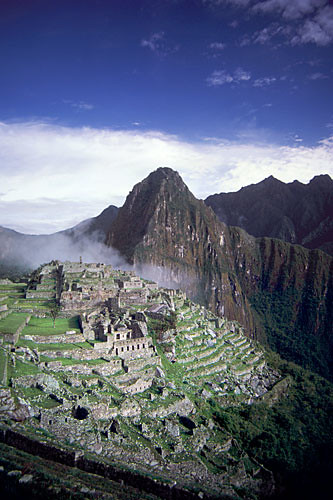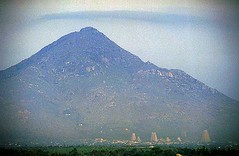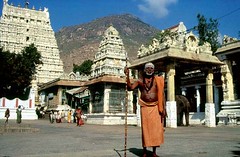Swami Vivekananda, on his life's work
"To put the Hindu ideas into English and then make out of dry philosophy and intricate mythology and queer startling psychology, a religion which shall be easy, simple, popular, and at the same time meet the requirements of the highest minds -- is a task only those can understand who have attempted it. The dry, abstract Advaita must become living -- poetic -- in everyday life; out of hopelessly intricate mythology must come concrete moral forms; and out of bewildering Yogi - ism must come the most scientific and practical psychology -- and all this must be put in a form so that a child may grasp it. That is my life's work"
Sunday, June 18, 2006
Swami Vivekananda - His life's work
Wednesday, June 14, 2006
On David Godman
David Godman is probably the foremost authority today on Bhagavan Ramana Maharishi's teachings. He is best known for his book "Be As you are", an authoritative and comprehensive collection of Bhagavan's teachings.
David Godman was born in England, in 1953. While he was attending Oxford University in the early 1970s he found himself being attracted to the teachings of Sri Ramana Maharshi. In 1976 he travelled to India, intending a brief visit to Ramana Maharshi's ashram and ended up living in Tiruvannamalai. After a period of intense meditation in the slopes of Arunachala for almost two years, he ran the ashram's library, leaving it in 1985 to devote himself to writing and serving Gurus like Sri Lakshmanaswamy and Mathru Sarada.
Though "Be as you are" even after its publication in the early 80s, still remains the most popular and widely read among Godman's books, he has written around 10 books on devotees and people like Sri Lakshmanaswamy, Annamalai Swami, and Papaji, who were all enlightened by the Grace of Bhagavan Ramana.
His painstaking research and commitment is clearly visible in all of his works. My personal favourite is "Living by the words of Bhagavan"-The life of Sri Annamalai Swami. I must have read this book at least half a dozen times, and can't tell you enough as to what it means to me. Before reading this book, I was not able to understand and appreciate the greatness of Bhagavan's teachings, as they appeared too dry, and to be honest, really seemed beyond my comprehension. "Living by the words of Bhagavan" is a truly moving account of Sri Annamalai Swami, an ashram worker, who had totally surrendered to Bhagavan and realised the Self by Bhagavan's grace. Very few references are available of Sri Annamalai Swami in the Ramanashram publications, and but for David Godman, Annamalai Swami's life and teachings would have remained unknown to the world at large.
Except "Be As you are", none of the other books of David Godman are widely available in book stores across India. If we have to get his books, it is possible to place an online order on his website, or buy the books directly from the book shop opposite to Ramanashram. A few of his books like Padamalai and the trilogy-"The Power of the Presence" are available in Ramanashram.
I would not be exaggerating, if I were to say that David Godman is a truly blessed person. Simply because, I cannot think of anybody who has had the good fortune to have interacted, served and written about four Jnanis in his / her lifetime.
His works till date (from the list on the Wikipedia page) are:
Be As You Are (edited): dialogues between Ramana Maharshi and visitors. This is the most widely read book on Ramana Maharshi's teachings.
No Mind - I am the Self: biographies and teachings of Lakshmana Swamy and Mathru Sri Sarada. Lakshmana Swamy is a direct disciple of Ramana Maharshi who realised the Self in his presence in 1949. Mathru Sri Sarada is his disciple. She realised the Self in Lakshmana Swamy's presence in 1978.
Living by the Words of Bhagavan: a biography of Annamalai Swami, a devotee of Ramana Maharshi who worked closely with the Maharshi in the 1930s and early 1940s. The book also contains dialogues that Annamalai Swami had with visitors in the late 1980s.Papaji Interviews (edited): a collection of interviews that various visitors had with Papaji (H. W. L. Poonja) in the early 1990s. Papaji is an enlightened disciple of Ramana Maharshi. The book also contains a lengthy introductory account of Papaji's early life and his association with Ramana Maharshi.Nothing Ever Happened: A three-volume biography of Papaji (H. W. L. Poonja)that chronicles his life up to the early 1980s.
Final Talks (edited): dialogues between Annamalai Swami and visitors to his ashram that took place in the last six months of his life.
The Power of the Presence (edited): A three-volume series that contains first-person accounts from devotees whose lives were transformed by Ramana Maharshi.Padamalai (translated and edited): This is derived from a long Tamil poem of the same name that was written by Sri Muruganar, a devotee of Ramana Maharshi. It contains teachings of Ramana Maharshi recorded by Muruganar in Tamil, along with extensive supporting quotations from other sources that contain Ramana Maharshi's teachings.
David Godman also regularly writes articles in the Mountain Path, the quarterly of Ramanashram. His website is informative, and I would recommend the interviews and personal stories section that gives a fine overview of the person that he is, and his work and his experiences.
I do earnestly believe that he is comparable to a Paul Brunton or Romain Rolland in bringing to light the lives and teachings of enlightened masters. India owes a debt of gratitude to David Godman for his work, and I am sure his service to the country by writing about the Ramana lineage, will be lauded in the times to come.
Monday, June 12, 2006
Arunachala - The Hill of the Holy Beacon(Part 2)
The Power of the Name of Arunachala
Arunachala & Machu Piccu - The connection!
Sri Bhagavan was of the view that Arunachala was the top of the spiritual axis of the earth and that there must be another mountain corresponding to Arunachala at exactly the opposite side of the globe. The other axis point is likely to be Machu Piccu in Peru where the Inca civilisation flourished. This site is quite amazing as the structure closely resembles the Sri Chakra.
Bhagavan has emphasised the glory of the name of "Arunachala" and has mentioned that one "Arunachala" is equivalent to 1 crore of "Om Namah Shivaya". Sri Bhagavan told a devotee that not everyone can see Chidambaram, not everyone can be born in Tiruvarur, and not everyone can die in Kasi, but anyone and everyone can think of Arunachala from wherever they may be, and they will definitely attain Moksha or Liberation.
Arunachala & Machu Piccu - The connection!
Sri Bhagavan was of the view that Arunachala was the top of the spiritual axis of the earth and that there must be another mountain corresponding to Arunachala at exactly the opposite side of the globe. The other axis point is likely to be Machu Piccu in Peru where the Inca civilisation flourished. This site is quite amazing as the structure closely resembles the Sri Chakra.
It is believed that individuals with psychic abilities have re-affirmed that the feminine or the Shakti power is immense in this mountain.
Sunday, June 11, 2006
Arunachala - The Hill of the Holy Beacon (Part 1)
Arunachala is the name of the sacred Hill in Tiruvannamalai, a town 180 kms from Chennai. It is believed to be the holiest of places, and the sacred place where Shiva himself is in the form of the Hill. This Hill is one of the Pancha Bhuta sthala representing the Agni tatvam and the place where Shiva manifested as the blazing column of light to humble Brahma and Vishnu who were both disputing among themselves as to who is the greater one. The manifestation of Shiva is known as Lingodhbhava, and is represented in Shiva temples behind the Garbha Graham.
This is the Hill where Bhagavan Ramana Maharishi spent most of his life. Bhagavan considered the Hill to be his Guru, and this Hill has attracted saints for thousands of years. Its glories have been sung by Manickavasagar, Guru Namashivaya, Guhai Namashivaya and Arunagirinathar. It is believed that many siddhas, invisible to our eyes still exist in this Hill.
The Giri Pradakshina or walking around the Hill is believed to be a very powerul spiritual practice, and was endorsed by Bhagavan Sri Ramana Maharishi, who till the 1920s used to do the Giri Pradakshina with his devotees. Ramana Maharishi prescribed very few practices, but he definitely urged people to do the Giri Pradakshina.
There is something more to this Hill than just being one of the Pancha Bhutha sthalas or another sacred place. The secret was revealed by Bhagavan who said that this is the "visible manifestation of the Self or Brahman". Though this aspect of Arunachala being the Self was conveyed by Isanya Jnana Desikar, a saint who lived in the 18th century, in his work Svanubhava Stotra Pamalai, it was Bhagavan who clearly highlighted the Hill as the Self or Brahman. The revelation of the secret of Arunachala is sung in verse 98 of his composition, Aksharamanamalai:
Veli/vittên/un/seyal
Verut/tidâ/dun/narul
Veli/vit/tenaik/kâ
Arunâ/chalâ.
I have betrayed Thy (secret) workings. Be not offended! Show me Thy grace now openly and save me, Oh Arunachala!
Being in the presence of Arunachala and having devotion to Arunachala is like being in the presence of a Jnani. The Hill is believed to teach through Silence like Lord Dakshinamurthy. The scriptures have enumerated the glories of this Hill and have even mentioned that the mere thought of Arunachala will bestow Liberation or Moksha. The Arunachala Mahatmyam in the Skanda purana states :
"That is the holy place! Of all Arunachala is the most sacred!It is the Heart of the world! Know it to be the secret and the sacred Heart centre of Shiva! In that place He always abides as the glorious Aruna Hill!""The supreme knowledge (Self-knowledge), the import of Vedanta, which cannot be attained without great difficulty, can easily be attained by anyone who sees the form of this hill from wherever it is visible or who even thinks of it by mind from afar."
The Ramanashram has brought out some lovely books like Ramana's Arunachala-Ocean of Grace Divine, Glory of Arunachala and a pictoral book "Heart is thy Name, O Lord!".
Subscribe to:
Posts (Atom)



